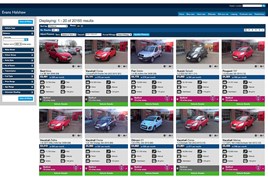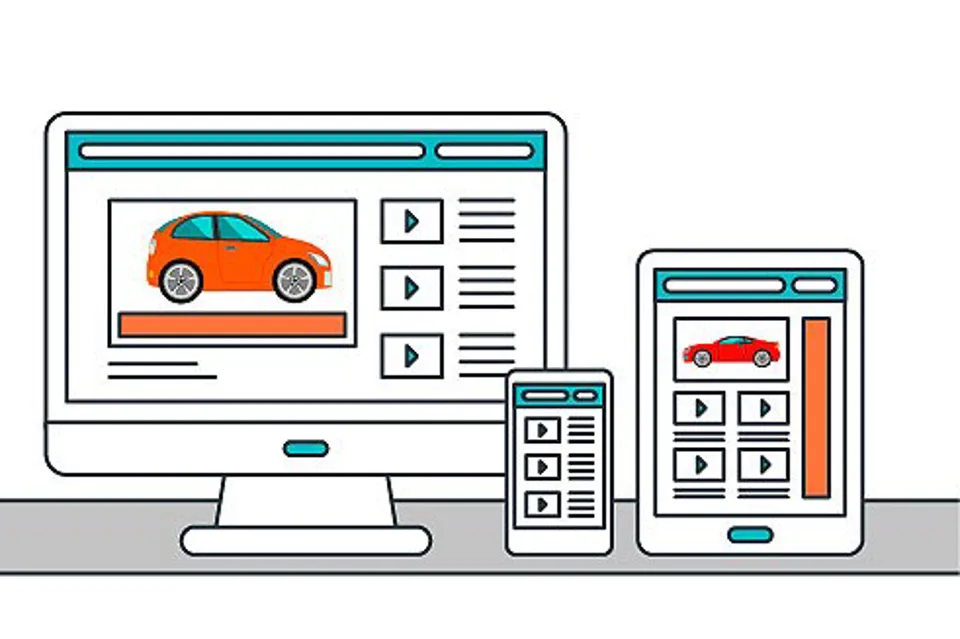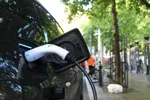A dealer’s website underpins every element of its digital presence and for 21st-century consumers, the ‘perfect’ website provides flawless functionality, relevant and regularly updated content, and useful tools and features including finance calculators, service booking, click-and-collect services and live chat.
Customers not only expect their experience to be unique, but they expect the transition between a dealer’s website and its physical showroom to be seamless.
Mobile responsiveness
Making the website compatible with a smartphone or tablet has to be one of the first priorities as that is likely to be how most customers will use the dealer’s website.
Tim Smith, group strategy director of GForces, said: “A major problem is lack of functionality, so having a responsive design is an absolute must in today’s market. Across our clients 60% of visits are made via either smartphones or tablets. A year ago it was just over 40%.”
Dealers should review what customers can do in the showroom and look to see how that can be replicated online.
After reviewing its old website, Arnold Clark identified functionality issues on smartphones and tablets, which was potentially a huge problem as about 60% of its traffic came from such devices.
High-quality images and videos now appear alongside content produced by an in-house newsroom, while the ability to search used cars, buy insurance, book appointments and access live chat functions is fully optimised for multiple devices.
Development is carried out by an in-house team, with sections of Arnold Clark’s 150-strong marketing department taking responsibility for their own element of the site, which won the AM Award in February for Best Website.
“Having a responsive design is an absolute must in today’s market. Across our clients 60% of visits are made via either smartphones or tablets. A year ago it was just over 40%” Tim Smith, GForces
The development of CarShop’s latest website, which launched in 2014, was inspired by the rapid growth in customers using mobile devices to view and search stock.
The proportion of visitors using tablets and smartphones went from less than 10% in 2012 to more than 30% a year later. The previous site was confusing and fiddly and the poor user experience was damaging the business.
CarShop’s primary objectives were to improve the customer experience and increase lead volumes through improved completion rates for enquiry forms and conversion rates. CarShop took a mobile-first approach to the new site’s design to ensure customers get a great experience, with faster response times for loading of pages and features.
Since the launch of the site, mobile traffic has risen to more than 50%. Shortly after launch, enquiry forms generated were up 90% year-on-year, online reserve-and-collect appointments had increased 36% and valuation appointments rose 28%.
Finance tools and online service booking
Finance integration delivering real-time finance quotes and options and an online car valuation functionality linked to robust data, are also key functional components for customers researching a new car purchase.
Smith said a good online finance quotation system can convert between 15% and 20% of leads into a sale.
A decent online booking function for servicing can contribute hugely to the amount of conversions driven by the website for the aftersales department.
GForces reported that some of its dealer clients are taking more than £200,000 a year in online service bookings.
Smith predicts dealer websites of the future will feature improved transactional features.
He said: “At present, they are very much browsing tools with enquiry points. The actual purchase of a car may be some way off – despite CapGemini Cars suggesting up to 44% of people would be prepared to – but websites will become a tool through which a customer can undertake all of the necessities other than signing the paperwork.”
Content – contact details, images and video
Justin Kirby, vice-president of content marketing at Tenthwave Digital, urges dealers to forget about formats and focus on creating a customer engagement strategy based on content.
He said: “If you’re thinking about content in specific formats, you’ve already failed. The format is irrelevant. You can use social media as a tool to deliver the content you’re intending, but it’s secondary to figuring out what sort of content you want to produce.”
Defining that content can be a bit like “nailing jelly to a table”, but Kirby urged retailers to go beyond the desk and reporting dashboards and really think about authentic, relevant and personal customer experiences.
“If you’re thinking about content in specific formats, you’ve already failed” Justin Kirby, Tenthwave Digital
“There do need to be some universal strategic considerations. Who is this content for?”
One example was US DIY company Lowes, which introduced a series of ‘Fix in Six’ video DIY tips. Video can also be a useful tool for converting aftersales work, with many dealerships using cameras in the servicing department to build trust with customers.
Kirby said: “Looking outside your industry is also essential. Your best experience is your best experience and it doesn’t matter whether that’s in travel or if it happened in a shop, or it happened on a website.
“Continually scan the market for what good content looks like.”
Customers need to be able to see a clear list of dealership locations and a way to contact each dealership either by email or phone. Nothing should be hidden away. This goes for stock on the website too.
Every car’s listing should be supported with exhaustive detail with high-quality images and video, covering every angle.
Smith said: “You see a lot of sites with really poor or missing images, which won’t convert people into interested parties.
Having a strong “about us” section on the website also provides dealers with a chance to show the heritage, values and personalities behind the business.
Customer communications – email, live chat and click-to-call
Interrogating the data collected from customers can be an effective way of putting more intelligence behind a dealer’s digital marketing.
Ian Godbold, Cambria Automobiles marketing director, put a policy across the group to reply to email enquiries within minutes, but going a few steps further, followed up communication after 24 hours, 72 hours and 14 days.
After analysing the 14-day response rates, Godbold said: “I was shocked at how many consumers made it half-way through their car-buying journey, then suddenly stopped.”
A 14-day contact strategy “helped put Cambria at the front of consumers’ minds”.
Anna Ling, marketing manager at Swansway, said analysis of message content and sending times showed 37% of customers book services as a result of email communication.
Following up on identified amber work with emails resulted in a 23% conversion rate. For customers with telephone data only, the rate is 14%.
Cleansing the group’s 100,000-record customer database and training everyone who uses it boosted turnover by £50,000 in one month and increased inbound service bookings by 84% year-on-year.
Jeremy Evans, managing director of Marketing Delivery, advised getting in touch with customers earlier than the traditional 28 to 30 days with service reminders.
“When you book a dentist appointment, it’s normal to do it six months ahead.
“Contact customers 60 days ahead of their required service and between a quarter and a third will make a booking before you would have normally reached out to them,” he said.
When CarShop was redeveloping its site, it integrated it into the CRM system to allow customer contact staff to retrieve online quotes, such as vehicle valuations, and complete the sales process over the telephone or by live chat.
Live chat has become one of the most popular ways for customers to interact online with any retailer or online service, but manning the service after hours is essential as there is generally a spike in activity in the evenings.
Make sure every phone number on a website is click-to-call. It helps to avoid any clunky copy and pasting on the part of the customer and removes another barrier to getting in contact with the dealership.
Search
Having good search functionality on the website is also essential.
Lauren Cooke, marketing manager at Bluesky Interactive, said: “Searches need to be more flexible and more intelligent. It is important to facilitate your customers’ behaviours, rather than dictate how they should search.
“Lifestyle search is likely to grow as people become more focused on needs rather than specific cars.”
Click and collect
 Pendragon’s move to launch a “click and collect” service over a year ago is the biggest indicator of how the automotive retail sector is moving toward a blended approach between physical and online sales.
Pendragon’s move to launch a “click and collect” service over a year ago is the biggest indicator of how the automotive retail sector is moving toward a blended approach between physical and online sales.
The top AM100 group’s Move Me Closer offer lets customers reserve a vehicle from their electronic device and choose to have it physically delivered to their nearest Evans Halshaw location for their viewing, on payment of a refundable £200 reservation fee.
Through this service, consumers can research and view online more than 21,000 vehicles then inspect the vehicle they reserved at a physical location convenient to them, backed by Evans Halshaw’s five-day price guarantee. The initiative is one of the biggest factors behind Pendragon’s 35.5% increase in web visits last year and record used gross profit up 11% to £15 million.
Case study: Perrys motor sales
Perrys Motor Sales has transformed the way it runs its digital operations since Lee Manning, digital marketing manager, joined in 2012.
Manning said the first step was asking customers where the group had been going wrong online.
“They believed we had made the website deliberately complicated and were hiding prices so they would call us.”
He put a team of marketing executives in place to speak daily with dealers about how to adapt to consumer behaviour.
“We began to ask people where they were on the journey and explain there were ways we could help them” Lee Manning, Perrys Motor Sales
One challenge was to ensure the amount and detail of information available in a showroom is available online, using consumer feedback to optimise the buying journey, and aiming to find out “what type of consumer are you and how can we take you to the product you want to test drive or buy?”
In practical terms, this included making language simple, ensuring images were big and clear, drop-down menus were easy to use and video was incorporated, on whatever platform consumers used.
Equally important was to ensure staff provided the experience expected by consumers.
“It’s not true that when they reach the showroom, they are ready to buy,” said Manning.
“They could be anywhere on the 24-touchpoint journey Google has identified consumers take in a car purchase. We began to ask people where they were on the journey and explain there were ways we could help them.”
Alongside this was the ambition to showcase the Perrys culture and its people and convince consumers it was the right dealer to buy from, ensuring a community of future customers.
Perrys’ website links to its YouTube channels on Car Buyer Guides, Car Care Guides and Vital Drive. Videos for each are produced in-house within dealerships’ normal operating hours.
Next month in the AM Best Practice Programme: Customer Service

















Login to comment
Comments
No comments have been made yet.